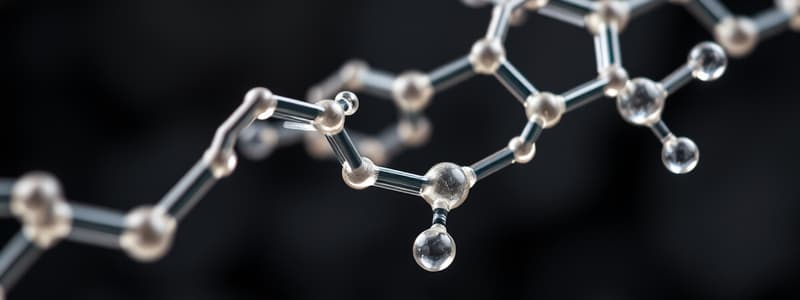Podcast
Questions and Answers
What are the 7 amino acids with ionizable side chains?
What are the 7 amino acids with ionizable side chains?
lysine, aspartic acid, cysteine, tyrosine, arginine, glutamic acid, histidine
What is the pKa of the lysine side chain?
What is the pKa of the lysine side chain?
10.5
What is the pKa of the aspartic acid side chain?
What is the pKa of the aspartic acid side chain?
3.9
What is the pKa of the cysteine side chain?
What is the pKa of the cysteine side chain?
What is the pKa of the tyrosine side chain?
What is the pKa of the tyrosine side chain?
What is the pKa of the arginine side chain?
What is the pKa of the arginine side chain?
What is the pKa of the glutamic acid side chain?
What is the pKa of the glutamic acid side chain?
What is the pKa of the histidine side chain?
What is the pKa of the histidine side chain?
What are the 9 nonpolar amino acids?
What are the 9 nonpolar amino acids?
What are the 6 polar amino acids?
What are the 6 polar amino acids?
What are the 5 charged amino acids?
What are the 5 charged amino acids?
What is the R group of lysine?
What is the R group of lysine?
What is the R group of aspartic acid?
What is the R group of aspartic acid?
What is the R group of cysteine?
What is the R group of cysteine?
What is the R group of tyrosine?
What is the R group of tyrosine?
What is the R group of arginine?
What is the R group of arginine?
What is the R group of glutamic acid?
What is the R group of glutamic acid?
What is the R group of histidine?
What is the R group of histidine?
Describe what an amino acid looks like in a vacuum.
Describe what an amino acid looks like in a vacuum.
Describe what an amino acid looks like in water.
Describe what an amino acid looks like in water.
Flashcards are hidden until you start studying
Study Notes
Ionizable Amino Acids
- Seven amino acids have ionizable side chains: lysine, aspartic acid, cysteine, tyrosine, arginine, glutamic acid, and histidine.
pKa Values of Ionizable Side Chains
- Lysine has a side chain pKa of 10.5.
- Aspartic acid's side chain pKa is 3.9.
- Cysteine's side chain pKa is 8.4.
- Tyrosine exhibits a side chain pKa of 10.5.
- Arginine has a side chain pKa of 12.5.
- Glutamic acid's side chain pKa is 4.1.
- Histidine shows a side chain pKa of 6.0.
Nonpolar Amino Acids
- Nine nonpolar amino acids include: glycine, alanine, valine, leucine, isoleucine, methionine, tryptophan, phenylalanine, and proline.
Polar Amino Acids
- Six polar amino acids are identified as: serine, threonine, cysteine, tyrosine, asparagine, and glutamine.
Charged Amino Acids
- Five amino acids are classified as charged: aspartic acid (acidic), glutamic acid (acidic), lysine (basic), arginine (basic), and histidine (basic).
Side Chain Structures
- Lysine's side chain: -CH2-CH2-CH2-CH2-NH3+.
- Aspartic acid's side chain: -CH2-COO-.
- Cysteine's side chain: -CH2-SH.
- Tyrosine's side chain: -CH2-benzene ring-OH.
- Arginine's side chain: -CH2-CH2-CH2-NH-C=NH2+-NH2.
- Glutamic acid's side chain: -CH2-CH2-COO-.
- Histidine's side chain: -CH2-amide ring-NH+.
Amino Acid in a Vacuum
- In a vacuum, the alpha amine group is deprotonated (NH2), while the alpha carboxylic group is protonated (COOH).
Amino Acid in Water
- When in water, the alpha amine group is protonated to form NH3+, and the alpha carboxylic group is deprotonated, resulting in COO-.
Studying That Suits You
Use AI to generate personalized quizzes and flashcards to suit your learning preferences.




